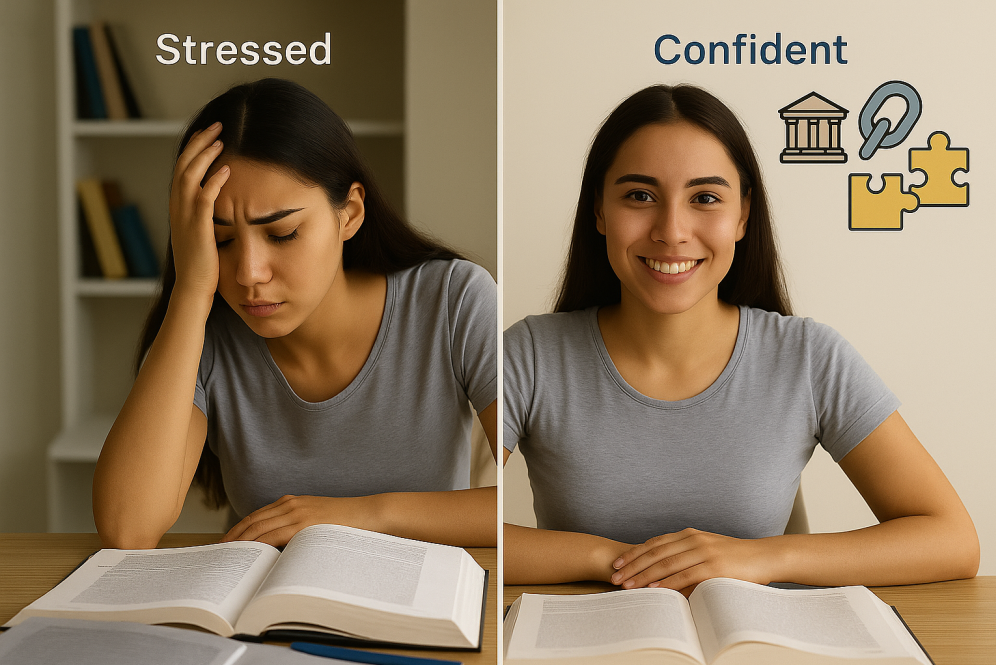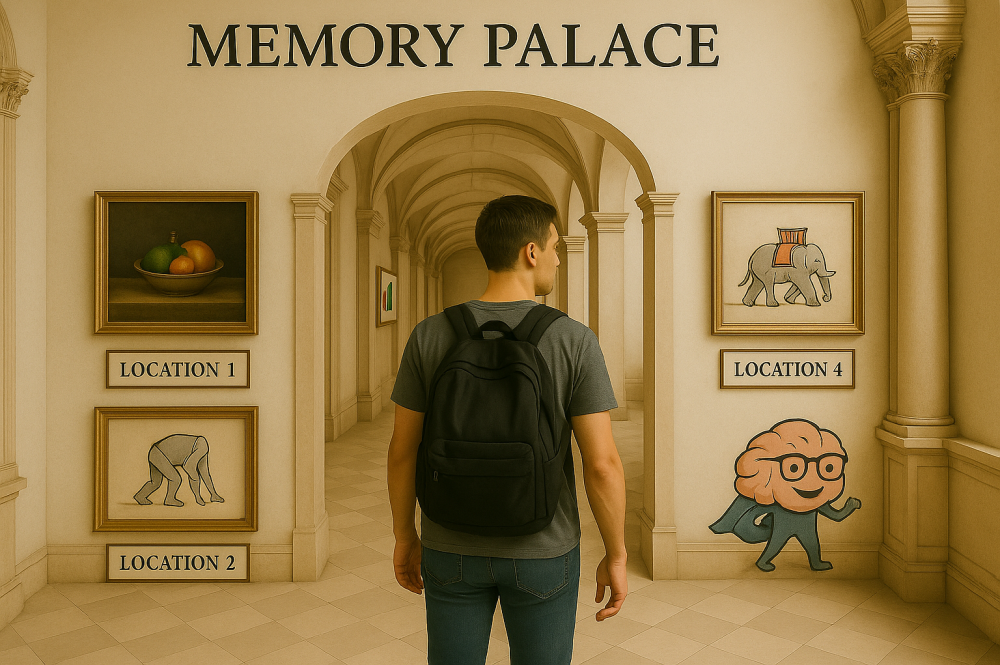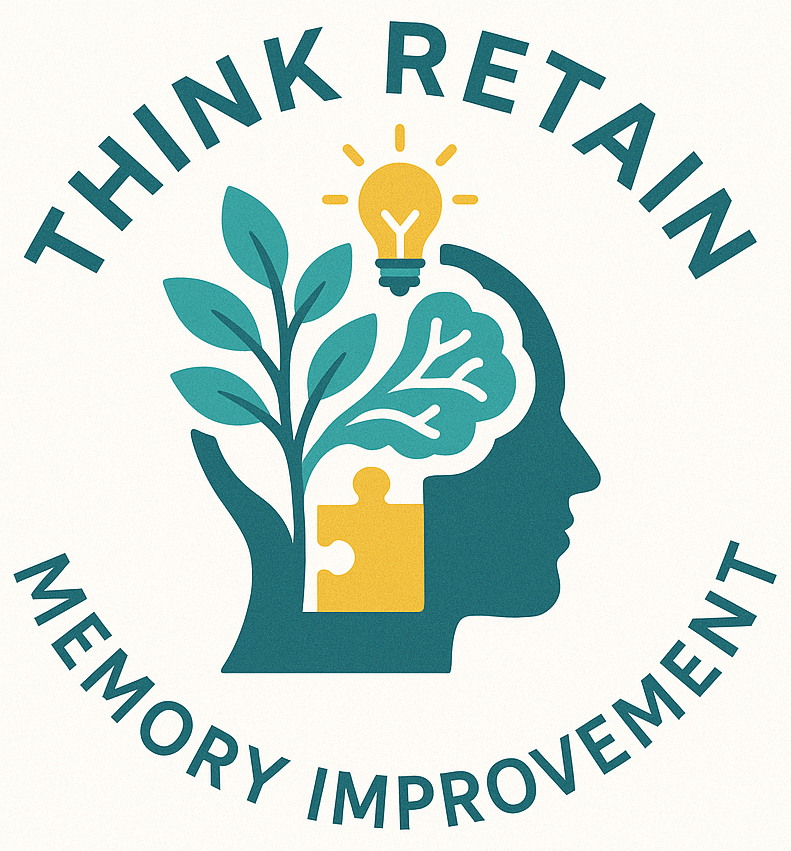
Ever found yourself staring blankly at your notes, overwhelmed by the sheer amount of information? Tackling this stress doesn’t mean working harder—it means working smarter. Memory techniques can transform your study habits into something that actually sticks.
What if you could recall more information and worry less about memory failures? Improving your memory is not just about cramming more into your brain. It’s about using your brain’s natural talents to make learning easier and even enjoyable. Think of memory enhancement as leveling up your study game.
Many tricks out there can seriously boost your memory power, and trust me, many of them go beyond what you already know. We’re diving right into both time-tested tips like the Memory Palace and fun twists like the Linking Method.
You might have heard the usual tips about getting enough sleep, eating brain food, and staying focused. While these are foundational, tapping into advanced mental techniques can really transform how you study. Most students stop at highlighting, but your brain? Man, it’s capable of so much more. Stick around as we explore underutilized methods that turn studying into a breeze.
Why Your Memory Fails You Sometimes

You’re not alone if your memory feels like it’s short-circuiting mid-study. Between stress, bad sleep, and information overload, your brain can only take so much. Sure, diet and rest help—but what if you had actual mental strategies to boost recall?
Now, if you’ve ever Googled tips for keeping your memory sharp, you’ve probably tripped over the basics: eat a balanced diet, get regular exercise, and engage in a good night’s sleep. You know the drill. These are crucial, no doubt, but leaning on these alone might not cut it when you’re knee-deep in study material.
Here’s where the cool stuff kicks in. Mental hacks like the memory palace and mnemonic devices aren’t just fancy terms. They’re tools that can take your brainpower to a whole new level. Kind of like giving your memory a superhero cape. Yet, despite their potential, many folks stick to basic methods like taking notes or highlighting.
Why do most students stop at just highlighting? Probably because that’s what everyone does. But there’s a world of techniques out there that tap into your mind’s more creative side, making information not just easier but also more fun to remember. So, how about we switch it up and explore some methods that might just surprise you?
Memory Hacks You Should Know
Let’s break down some memory techniques that often sound mysterious but are incredibly practical once you get the hang of them. Ever heard of the 7-3-2-1 memorization method? It’s a structured approach to help in memorizing patterns efficiently. This involves actively engaging with the material over different intervals, ensuring you aren’t just cramming but actually retaining information.
Another game changer is the 2-7-30 rule for memory. This nifty technique revolves around short and consistent reviewing. The idea is to review the material after 2 days, then again after 7 days, and finally, another review after 30 days. It taps into the concept of spaced repetition, giving your brain a better shot at long-term retention.
But I can’t leave out the 7-3-2-1 study method. This isn’t just about memorization. It’s a study cycle that’s designed for effective learning. You focus on a topic for 7 minutes, take a brief break of 3 minutes, then review what you learned for 2 minutes, and finally, end with a 1-minute pause to reflect. It’s about cultivating a rhythm that balances focus and rest.
These methods might sound a bit formulaic, but they’ve got science backing them up. They’re rooted in how our brains naturally prefer to process and recall information. So, if you’ve been doing straight reading or endless highlighting, giving these a shot might just change your entire study experience to something more memorable.

Getting down these techniques is just the start. They’re blueprints you can adapt based on what feels right for you. Whether it’s a solo cram session or group study, these methods offer a strategic edge that most students overlook.
How To Build A Memory Palace
The Memory Palace Technique, also known as the Method of Loci, leverages the brain’s knack for spatial memory. Picture picking a path through a house you know super well, then mentally planting information within that space. Memories tied to specific locations are easier to recall, making this technique a nifty way to store and retrieve data.
Start by visualizing a place you’re incredibly familiar with. Could be your childhood home, your school, or even a favorite coffee shop. Each room or area becomes a “slot” for your information. The trick is to create a vivid mental map.
Assign a piece of information to each specific location along your route. Say you need to memorize historical dates. Imagine placing the Victory of Waterloo in your living room and the invention of the printing press in the kitchen. The crazier the visuals, the better!
As you memorize, mentally “walk” through your palace, retrieving information. Revisit this mental journey regularly; it’s all about repetition and reinforcement. The more creative you get with your imagery, the more memorable your palace becomes.
This technique’s brilliance lies in its adaptability. Whether you’re preparing for a biology exam or trying to remember names for a meeting, the Memory Palace is your personal, mental filing cabinet. Start small, get creative, and let your memory palace handle the rest.

Turn Lists Into Stories: Linking and Repetition
Memory can often feel like a slippery fish, but with the right methods, you can get it to stick. The Linking, or Chain Method, is an adventure in creativity and association that turns routine memorization into a vivid mental story.
To kick this off, you start by taking a list of items or concepts and linking them together with a story. Each item connects to the next through a creative narrative. Here’s a quirky example: you need to memorize a grocery list containing milk, bananas, and bread. Picture a gorilla (because bananas) swimming in a giant pool of milk, using a loaf of bread as a floatie. It’s bizarre, but trust me, that’s how it sticks.

This method taps into your brain’s natural fondness for stories. By weaving information into a cohesive tale, recalling individual items becomes easier since they’re all parts of one whole narrative.
Pair this with the technique of Spaced Repetition, and you’ve got a powerhouse combo. By reviewing information at increasing intervals—say, Day 1, Day 2, Day 5, Day 7, and so forth—you nip forgetting in the bud and reinforce memory pathways.
The repetition schedule might seem a bit mechanical, but spaced repetition capitalizes on maximizing retention with minimal effort. You’re essentially hacking the way the brain responds to information over time. It’s reinforcing without anxiety.
Together, the Linking Method and Spaced Repetition bake memorization into your daily routine, making the once tedious task of remembering more natural and less daunting.
Memory Boosters Most Students Ignore
So you’re all set up with some robust memory tools, but let’s sprinkle in a few more tweaks to your study routine that can boost memory even more.

Try keeping things light and silly. Deep dives into serious content can feel like your brain’s stuck in a blender. Using humor or ridiculousness while memorizing can spark your memory! It’s way easier to remember something funny or absurd than something dull.
And how about just saying things out loud? It might feel goofy at first, but verbalizing information can enhance recall. It’s like practicing for a speech: the more you hear it, the more natural it feels to remember.
There’s also power in keeping it short. Overloading doesn’t work, but digestible pieces do. Break up your study material into bite-sized chunks.
These extra tricks might seem small, but together they make a big impact. They could be the difference between ‘I know this, but I can’t remember it’ and ‘Got it!’ Memory isn’t just about cramming or brute force—it’s about smart strategies.
Embracing these techniques might just transform the way you approach your studies. You’ll find not only more power in your recall but also more efficiency and confidence in the process.
So why not experiment with these newfound skills the next time you’re hitting the books? You’ve got a solid set of tools now, ready to make those study sessions count and maybe even have a bit of fun in the process.

Wow, I really wish I had come across these memory improvement techniques back in my school years! I remember cramming the night before exams and hoping for the best—had I known about spaced repetition and mnemonic devices, I think studying would’ve been way less stressful and much more effective.
The section on visualization really stood out to me. It’s amazing how something as simple as associating ideas with images can make information stick so much better. I’m even thinking of applying some of these techniques now as a mom who’s always learning new things and trying to stay sharp!
Do you think these techniques work just as well for adults who are out of school but still want to improve their memory for everyday tasks or self-learning? And for students who struggle with focus, which technique would you recommend they start with?
Thanks for such a practical and informative post. ????
Hello, Alice.
To answer your question, the memory arts work very well for adults, including 60-plus people like me. I’ve had a fascination with the memory arts since my 20s, but it’s become even more relevant for me since my mother developed alzheimer’s dementia. Doctors encourage older people to do Sudoku and crossword puzzles to build up neural reserve. I wish I could tell you that research has shown that practising the memory arts develops your brain and grows neural reserve, but I can’t do so in all honesty. However, I can say this: if you practice the memory arts, such as experimenting with the link method and memory palaces, you’ll ask yourself, “How could this not be developing my brain?”
As far as focus and concentration problems are concerned, I can tell you about that because I have advanced ADHD. The reason I gravitate towards the memory arts is that I’m not a square peg who fits in a square hole. I have no choice but to think outside of the clichéd box because I’m locked outside of it. So, yes, this is for students who struggle with focus and concentration. I recommend you start with the link method. Lead them through a link exercise and watch their faces light up when they experience what their brains are capable of. It’s a joy to watch, especially if these students were taught to believe there was something wrong with them, that they are somehow defective. Believe me, I know. Read my About David page to get my backstory.
The most common question we ask about these techniques is, “Why, oh why, don’t they teach this in schools?!” The thing is, it was taught in schools thousands of years ago. Thousands of years ago, there was a whole pedagogy built around the art of memory. When we were in school, we were taught the three Rs–Reading, wRiting, and aRithmetic. In ancient Greece & Rome, students were taught the four Rs–Reading, wRiting, aRithmetic and Remembering. And there are cultures that have been teaching the memory arts even longer. The Australian Aboriginals, for example, memorised the whole interior of Australia, including trails that are now underwater. What this means is they memorised trails that were in use during the Ice Age when the oceans’ water levels were lower. We’re talking 10,000 years ago! If you’d like to learn more, I recommend visiting Amazon and ordering The Memory Code by Lynne Kelly. It’s a fascinating read.
So, what happened to the art of memory? Johann Gutenberg invented the printing press, allowing people to preserve their knowledge in books instead of relying on their trained memory. The result of this is that the art of memory was ironically forgotten. The only memory arts that remained were the parlour tricks–memorising a deck of cards, remembering everyone’s name in the room. I don’t want to memorise a deck of cards. The very notion of memorising a deck of cards bores me to tears. I want to memorise books, foreign languages, scientific vocabulary, poetry, and other things worth remembering that grow my brain. I’ll bet you do, too.
Memory techniques can truly make a difference, especially for students juggling multiple subjects. I’ve noticed that methods like spaced repetition and active recall work well for technical topics, but I wonder how effective they are for more abstract or conceptual subjects like philosophy or literature. Are certain memory strategies better suited for different types of content? Also, how important is sleep and diet in maximizing the effectiveness of these techniques? It would be great to hear more about how lifestyle factors integrate with cognitive strategies. Has there been any research comparing long-term retention between traditional study methods and these newer memory-focused approaches?
We’re on the same page, my friend. To answer your first question, yes, specific memory strategies are better suited for different types of content. For example, the way you memorise a foreign language and the way you memorise a scientific formula aren’t quite the same. There are several memory strategies in existence besides the link method and the memory palace. There’s the syllabic clue technique, the nested images technique, the pillar technique and others you probably haven’t heard of. You’ll find that all of them work best within a memory palace. The key is to find the right combination of techniques that works best for the subject you are trying to learn.
As far as lifestyle is concerned, I can tell you from experience that refined sugars interfere with learning. I recently cut them out because I was trying to lose weight, and I noticed that my focus had sharpened and my general memory had improved. The only sugars I get now are natural ones from fresh fruit.
As for the research, studies have been conducted on these techniques. I recommend reading “Moonwalking with Einstein” by Joshua Foer for more details. What’s interesting about your question about “these newer memory-focused approaches” is that they’re not new at all. They are, in fact, thousands of years old, predating the printing press by millennia. I also recommend The Memory Code by Lynne Kelly, a fascinating read that will also give you more details on just how ancient these techniques are.